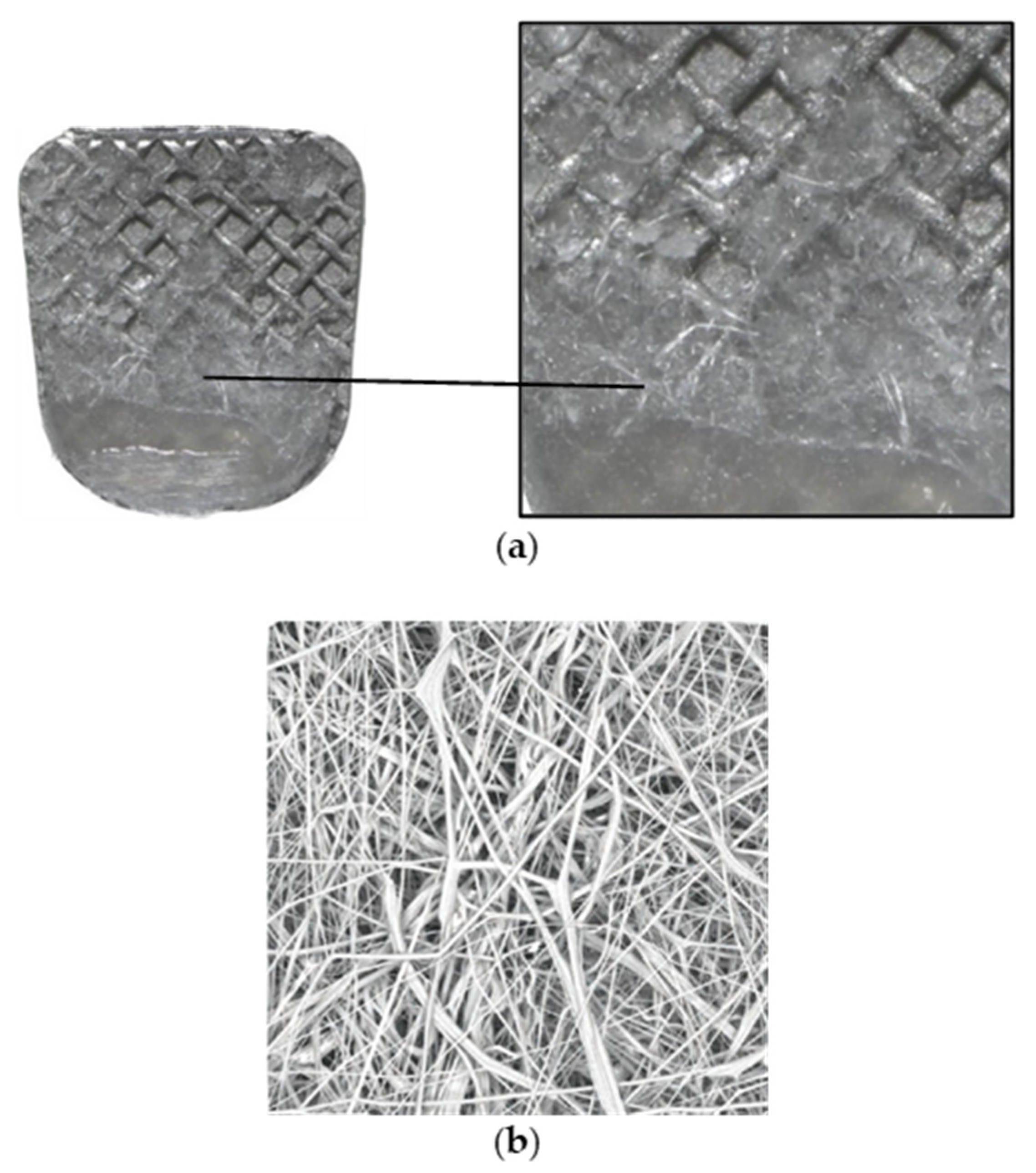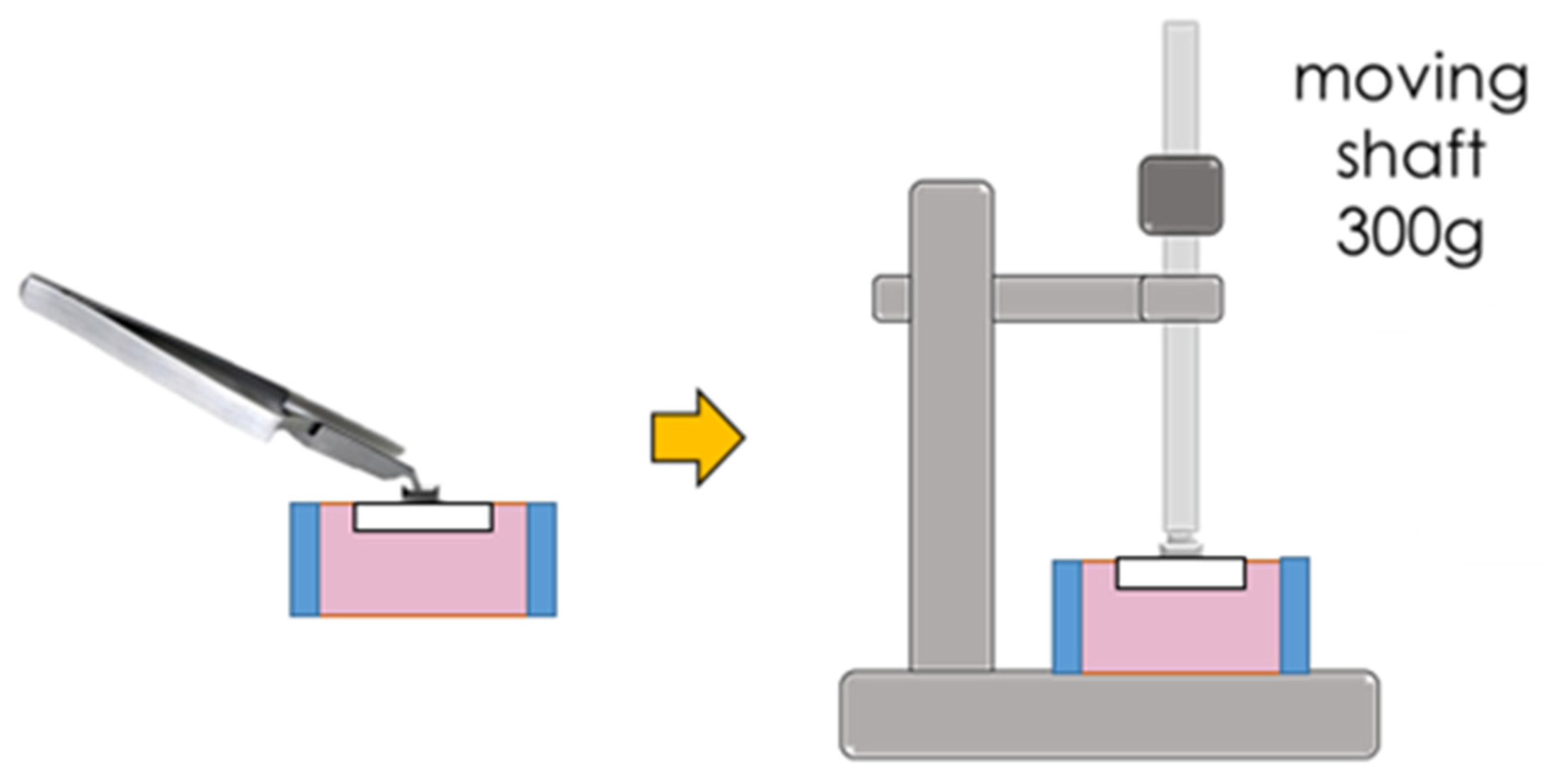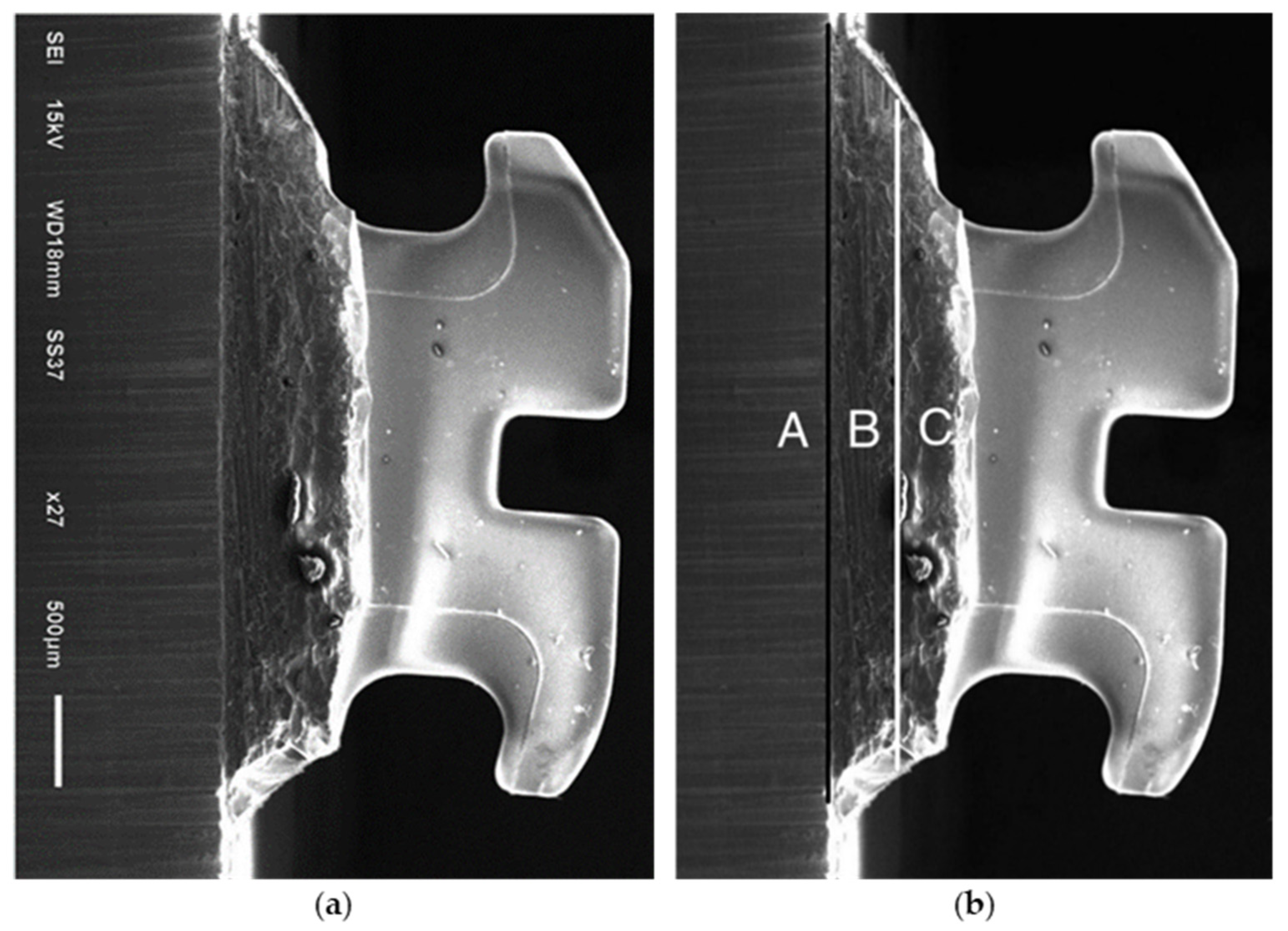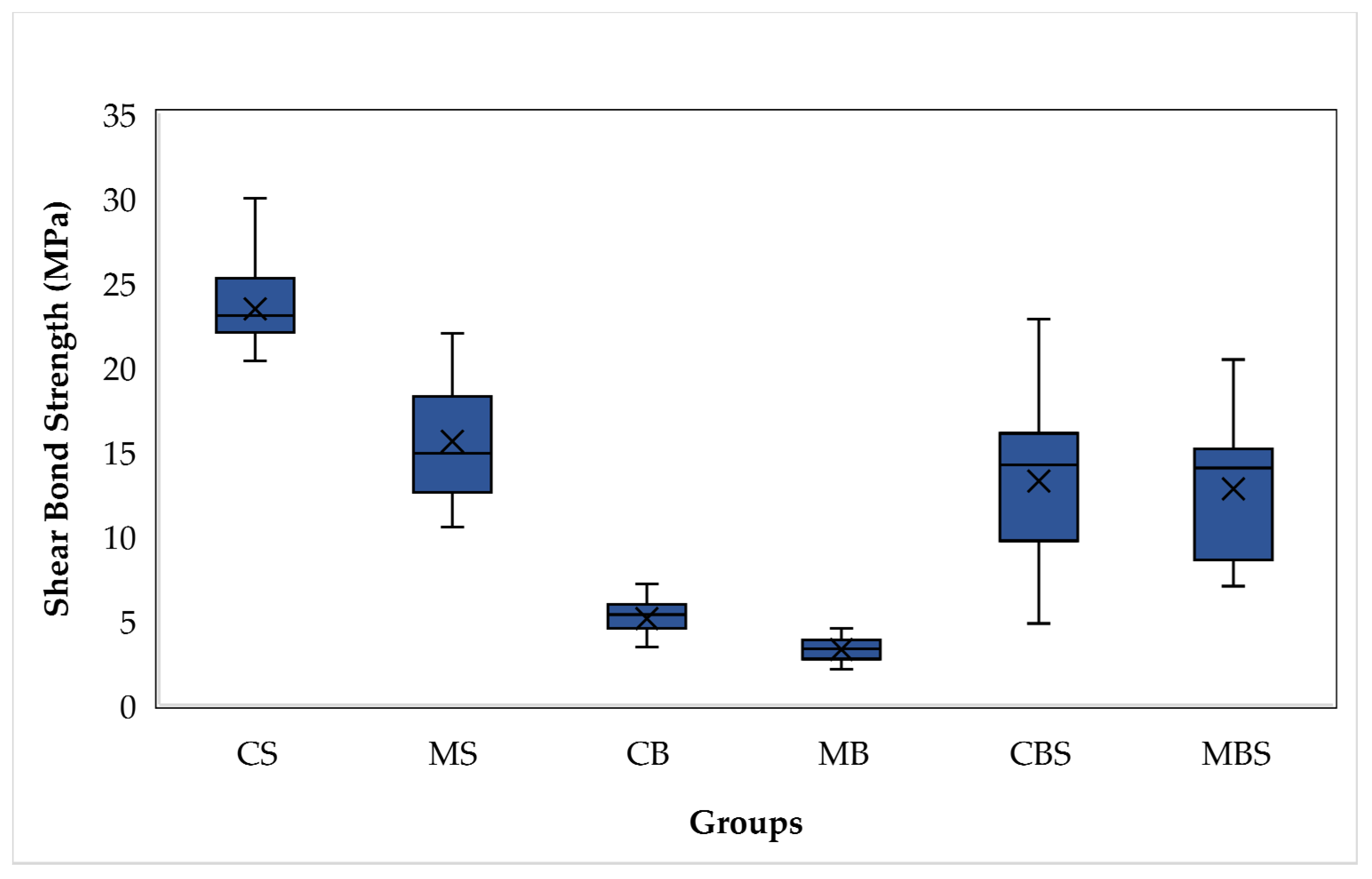Shear Bond Strength of Polypropylene Fiber in Orthodontic Adhesive on Glazed Monolithic Zirconia
Abstract
1. Introduction
2. Materials and Methods
2.1. Sample Preparation
2.2. Data Collection
2.2.1. Shear Bond Strength
2.2.2. Mode of Failure
2.3. Data Analysis
3. Results
3.1. Shear Bond Strength
3.2. Mode of Failure
4. Discussion
4.1. Shear Bond Strength
4.2. Mode of Failure
5. Conclusions
Author Contributions
Funding
Institutional Review Board Statement
Informed Consent Statement
Data Availability Statement
Conflicts of Interest
References
- Sjogren, G.; Lantto, R.; Granberg, A.; Sundstrom, B.O.; Tillberg, A. Clinical examination of leucite-reinforced glass-ceramic crowns (Empress) in general practice: A retrospective study. Int. J. Prosthodont. 1999, 12, 122–128. [Google Scholar] [PubMed]
- Piconi, C.; Maccauro, G. Zirconia as a ceramic biomaterial. Biomaterials 1999, 20, 1–25. [Google Scholar] [CrossRef]
- Bona, A.D.; Pecho, O.E.; Alessandretti, R. Zirconia as a Dental Biomaterial. Materials 2015, 8, 4978–4991. [Google Scholar] [CrossRef] [PubMed]
- Christel, P.; Meunier, A.; Heller, M.; Torre, J.P.; Peille, C.N. Mechanical properties and short-term in-vivo evaluation of yttrium-oxide-partially-stabilized zirconia. J. Biomed. Mater. Res. 1989, 23, 45–61. [Google Scholar] [CrossRef] [PubMed]
- Al-Amleh, B.; Lyons, K.; Swain, M. Clinical trials in zirconia: A systematic review. J. Oral Rehabil. 2010, 37, 641–652. [Google Scholar] [CrossRef] [PubMed]
- Manicone, P.; Rossi Iommetti, P.; Raffaelli, L. An Overview of Zirconia Ceramics: Basic Properties and Clinical Applications. J. Dent. 2007, 35, 819–826. [Google Scholar] [CrossRef]
- Miyazaki, T.; Nakamura, T.; Matsumura, H.; Ban, S.; Kobayashi, T. Current status of zirconia restoration. J. Prosthodont. Res. 2013, 57, 236–261. [Google Scholar] [CrossRef]
- Nistor, L.; Grădinaru, M.; Rîcă, R.; Mărășescu, P.; Stan, M.; Manolea, H.; Ionescu, A.; Moraru, I. Zirconia Use in Dentistry—Manufacturing and Properties. Curr. Health Sci. J. 2019, 45, 28–35. [Google Scholar] [CrossRef]
- Ozkurt Kayahan, Z. Monolithic Zirconia: A review of the literature. Biomed. Res. 2016, 27, 1427–1436. [Google Scholar]
- Aksoy, G.; Polat, H.; Polat, M.; Coskun, G. Effect of various treatment and glazing (coating) techniques on the roughness and wettability of ceramic dental restorative surfaces. Colloids Surf. B Biointerfaces 2006, 53, 254–259. [Google Scholar] [CrossRef]
- Alves, L.M.M.; Contreras, L.P.C.; Bueno, M.G.; Campos, T.M.B.; Bresciani, E.; Valera, M.C.; Melo, R.M.d. The Wear Performance of Glazed and Polished Full Contour Zirconia. Braz. Dent. J. 2019, 30, 511–518. [Google Scholar] [CrossRef] [PubMed]
- Kim, Y. Study on the perception of orthodontic treatment according to age: A questionnaire survey. Korean J. Orthod. 2017, 47, 215–221. [Google Scholar] [CrossRef] [PubMed]
- McMorrow, S.M.; Millett, D.T. Adult orthodontics in the Republic of Ireland: Specialist orthodontists’ opinions. J. Orthod. 2017, 44, 277–286. [Google Scholar] [CrossRef] [PubMed]
- Matinlinna, J.P.; Lung, C.Y.K.; Tsoi, J.K.H. Silane adhesion mechanism in dental applications and surface treatments: A review. Dent. Mater. 2018, 34, 13–28. [Google Scholar] [CrossRef] [PubMed]
- Thanetchaloempong, W.; Riowruangsanggoon, D.; Sirisoontorn, I. Comparison of Shear Bond Strength Between Uncoated and Precoated Orthodontic Brackets: A Systematic Review. J. Int. Dent. Med. Res. 2022, 15, 891–895. [Google Scholar]
- Chaimaungchuen, K.; Riddhabhaya, A.; Niyomtham, N.; Sirisoontorn, I. Shear Bond Strength and Mode of Failure of Polypropylene Fibers in Orthodontic Flash-Free Adhesive. Polymers 2022, 14, 4167. [Google Scholar] [CrossRef]
- The number of adults seeking orthodontic treatment in the UK continues to rise. Br. Dent. J. 2018, 224, 847. [CrossRef]
- Grewal Bach, G.K.; Torrealba, Y.; Lagravère, M.O. Orthodontic bonding to porcelain: A systematic review. Angle Orthod. 2014, 84, 555–560. [Google Scholar] [CrossRef]
- Reynolds, I.R. A Review of Direct Orthodontic Bonding. Br. J. Orthod. 1975, 2, 171–178. [Google Scholar] [CrossRef]
- Imani, M.M.; Pouyanfar, H.; Tabaii, E.; Bakhtiari, M.; Teimourian, H. Shear Bond Strength of Metal Brackets to Zirconia Following Different Surface Treatments using a Universal Adhesive. J. Clin. Diagn. Res. 2019, 13, 20–23. [Google Scholar] [CrossRef]
- Lee, J.Y.; Ahn, J.; An, S.I.; Park, J.W. Comparison of bond strengths of ceramic brackets bonded to zirconia surfaces using different zirconia primers and a universal adhesive. Restor. Dent. Endod. 2018, 43, e7. [Google Scholar] [CrossRef] [PubMed]
- Cetik, S.; Ha, T.H.; Sitri, L.; Duterme, H.; Pham, V.; Atash, R. Comparison of Shear Strength of Metal and Ceramic Orthodontic Brackets Cemented to Zirconia Depending on Surface Treatment: An In Vitro Study. Eur. J. Dent. 2019, 13, 150–155. [Google Scholar] [CrossRef] [PubMed]
- Kwak, J.-Y.; Jung, H.-K.; Choi, I.-K.; Kwon, T.-Y. Orthodontic bracket bonding to glazed full-contour zirconia. Restor. Dent. Endod. 2016, 41, 106–113. [Google Scholar] [CrossRef] [PubMed]
- Artun, J.; Bergland, S. Clinical trials with crystal growth conditioning as an alternative to acid-etch enamel pretreatment. Am. J. Orthod. 1984, 85, 333–340. [Google Scholar] [CrossRef]
- Charoenbhakdee, S.; Lauvahutanon, S.; Sirimethawong, Y.; Jiangkongkho, P. Effect of Silane Coupling Agent on the Shear Bond Strength Between Lithium Disilicate Glass Ceramic and Composite Resin. Chiang Mai Dent. J. 2022, 43, 23–34. [Google Scholar]
- Kassem, H.; Douara, Y.; Mowafy, M.; Abdelkader, S. Evaluation of the shear bond strength of ceramic orthodontic brackets to glazed monolithic zirconia. Egypt. Orthod. J. 2019, 56, 9–20. [Google Scholar]
- Thurmond, J.W.; Barkmeier, W.W.; Wilwerding, T.M. Effect of porcelain surface treatments on bond strengths of composite resin bonded to porcelain. J. Prosthet. Dent. 1994, 72, 355–359. [Google Scholar] [CrossRef]






| Group | N | Mean ± SD | Max | Min |
|---|---|---|---|---|
| CS | 10 | 23.42 ± 3.88 a | 29.99 | 16.13 |
| MS | 10 | 15.57 ± 4.01 b | 21.98 | 10.53 |
| CB | 10 | 5.09 ± 1.50 c | 7.15 | 2.12 |
| MB | 10 | 3.26 ± 0.76 c | 4.51 | 2.08 |
| CBS | 10 | 13.23 ± 5.47 b | 22.81 | 4.80 |
| MBS | 10 | 12.77 ± 4.43 b | 20.42 | 7.01 |
| Group | CS | MS | CB | MB | CBS | MBS |
|---|---|---|---|---|---|---|
| CS | - | 7.85 * | 18.33 * | 20.16 * | 10.19 * | 10.65 * |
| MS | - | 10.48 * | 12.31 * | 2.34 | 2.81 | |
| CB | - | 1.83 | −8.14 * | −7.67 * | ||
| MB | - | −9.97 * | −9.50 * | |||
| CBS | - | 0.47 | ||||
| MBS | - |
| Group | N | ARI Score 1 | |||
|---|---|---|---|---|---|
| 0 (%) | 1 (%) | 2 (%) | 3 (%) | ||
| CS | 10 | 0 (0) | 7 (70) | 1 (10) | 2 (20) |
| MS | 10 | 0 (0) | 6 (60) | 4 (40) | 0 (0) |
| CB | 10 | 10 (100) | 0 (0) | 0 (0) | 0 (0) |
| MB | 10 | 10 (100) | 0 (0) | 0 (0) | 0 (0) |
| CBS | 10 | 0 (0) | 9 (90) | 1 (10) | 0 (0) |
| MBS | 10 | 2 (20) | 6 (60) | 2 (20) | 0 (0) |
Publisher’s Note: MDPI stays neutral with regard to jurisdictional claims in published maps and institutional affiliations. |
© 2022 by the authors. Licensee MDPI, Basel, Switzerland. This article is an open access article distributed under the terms and conditions of the Creative Commons Attribution (CC BY) license (https://creativecommons.org/licenses/by/4.0/).
Share and Cite
Riowruangsanggoon, D.; Riddhabhaya, A.; Niyomtham, N.; Sirisoontorn, I. Shear Bond Strength of Polypropylene Fiber in Orthodontic Adhesive on Glazed Monolithic Zirconia. Polymers 2022, 14, 4627. https://doi.org/10.3390/polym14214627
Riowruangsanggoon D, Riddhabhaya A, Niyomtham N, Sirisoontorn I. Shear Bond Strength of Polypropylene Fiber in Orthodontic Adhesive on Glazed Monolithic Zirconia. Polymers. 2022; 14(21):4627. https://doi.org/10.3390/polym14214627
Chicago/Turabian StyleRiowruangsanggoon, Dhanabhol, Apiwat Riddhabhaya, Nattisa Niyomtham, and Irin Sirisoontorn. 2022. "Shear Bond Strength of Polypropylene Fiber in Orthodontic Adhesive on Glazed Monolithic Zirconia" Polymers 14, no. 21: 4627. https://doi.org/10.3390/polym14214627
APA StyleRiowruangsanggoon, D., Riddhabhaya, A., Niyomtham, N., & Sirisoontorn, I. (2022). Shear Bond Strength of Polypropylene Fiber in Orthodontic Adhesive on Glazed Monolithic Zirconia. Polymers, 14(21), 4627. https://doi.org/10.3390/polym14214627








